|
|
| |
 |
| |
New Zealand's fauna is interesting because it includes parrots and parakeets which are normally associated with the world's tropical regions, while at the same time accommodating penguin which also occupy the Antarctic region. Three parrots and six parakeets are endemic. Strikingly different parakeet locations range from the subtropical Kermadec Islands, to the subantarctic Auckland Islands which is the second most southerly parrot location on Earth. Habitats range from temperate rainforest to tussock grassland. |
Kea Nestor notabilus
The kea is New Zealand's cheakiest and naughtiest bird, renowned for chewing windshield wipers and other appendages off cars. Despite this mischief it is greatly loved. It is thought to be the most intelligent bird in the world. The kea is the world's only alpine parrot, living in the subalpine regions and high country of the South Island by adapting to changes in their habitat and becoming scavengers. |
|
|
The kakapo is one of the world's most critically endangered birds, living dangerously
close to extinction for more than half a century. It is the world's heaviest parrot, and the only flightless and nocturnal parrot. After many years of holding on with just a few females in New Zealand's most extensive controlled breeding program, the future looks better for kakapo since a record number of chicks hatched in 2008, bringing the total to over 100 birds.
 See more See more
 Hear the booming call of male kakapo
Hear the booming call of male kakapo
[needs RealPlayer to run]
 INSTALL REALPLAYER INSTALL REALPLAYER |
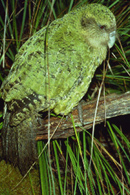 |
Kaka Nestor meridionalis
Once abundant throughout forests on the North, South and Stewart Islands, both subspecies of kaka which are found only in New Zealand, are following a similar decline to that of kiwi. Remaining populations have become predominently male due to stoat predation of females and chicks in nests. Kaka are on the path to mainland extinction, and may eventually only exist in protected 'mainland island' sanctuaries, and on predator-free offshore islands. |
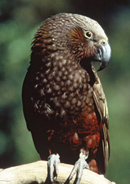 |
|
The NZ red-crowned parakeet is one of 4 red-crowned species in a wide range of tropical to subantarctic locations. Four previous C. novaezelandiae subspecies, each in New Caledonia, and on Norfolk, Antipodes and Macquarie Islands were reclassified in 2001 as different species. It is rarely seen on the NZ mainland islands, but Stewart Island, some offshore islands, and Ewing Island in the subantarctic Auckland Islands are strongholds. Two subspecies are on the Kermadec and Chatham Islands.  See more See more |
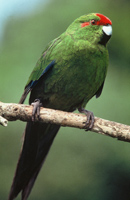 |
Orange-fronted parakeet
Cyanoramphus malherbi
The number of orange-fronted parakeet plummeted 75 percent in three years, after it was declared a separate species in 2001. It has quickly become one of New Zealand's most endangered birds, joining the takahe, kakapo and black robin. Only 100-200 birds remain in two valleys in Arthurs Pass National Park and Lake Sumner Forest Park in North Canterbury. Birds are being translocated to predator-free Chalky Island in Fiordland. |
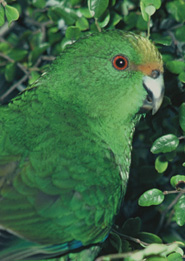 |
|
The Antipodes Island parakeet is only on the cold, bleak and unforested subantarctic
Antipodes Island, 770km southeast of the South Island. It is the world's third most southerly parrot location. Deep genetic separation of the Antipodes species from other New Zealand parakeets, indicates that its' colonisation of the island must have occurred before the radiation of red-crowned, yellow-crowned and orange-fronted species.
 See more See more |
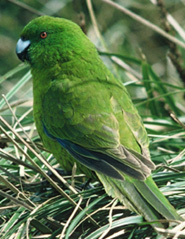 |
|
Yellow-crowned parakeets are more common on the North and South Islands than the only other mainland species, the NZ red-crowned parakeet. The two share the subantarctic Auckland Islands, the most southern parrot location. While severely reduced, it is still in large native forest tracts. Endangered orange-fronted parakeets split from yellow-crowned, and Little Barrier Island birds may be the forebearers of the extinct North Island orange-fronted species.
 See more See more |
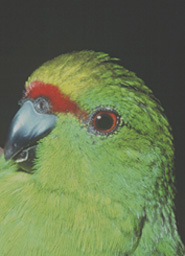 |
Forbes' parakeet Cyanoramphus forbesi
The taxonomy of Forbes' parakeet has been debated since it was first described as a distinct species in 1893, then demoted to a subspecies of yellow-crowned parakeet in 1930. Genetic research in 2001 redeems its' separate species status, and connects its lineage to the Chatham Island red-crowned parakeet. Forbes' parakeet is endemic to Mangere Island in the Chatham Islands, and is seriously endangered because of hybridisation with red-crowned parakeet. |
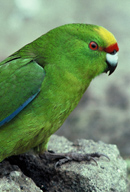 |
|
Correction to 2001 examination of the molecular systematics of Reischek's parakeet elevated it to a full species, after previously being described as a subspecies of the New Zealand red-crowned parakeet, and as the only surviving subspecies of the extinct Macquarie Island red-crowned parakeet C. erythrotis. Reischek's parakeet shares the windblown, bleak and treeless 60 sq.km subantarctic Antipodes Island habitat with the Antipodes Island parakeet. They have not interbred since Reischek's parakeet arrived on the island as a later colonisation.
 See more See more |
| |
 |
| |
|

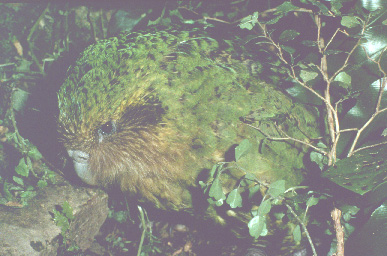
| |
2009 IUCN Red List of Threatened Species
Kakapo
Strigops habroptilus
Critically endangered
Kea
Nestor notabilis
Vulnerable
Kaka
Nestor meridionalis
Endangered
Orange-fronted parakeet
Cyanoramphus malherbi
Critically endangered
Forbes' parakeet
Cyanoramphus forbesi
Endangered
Antipodes parakeet
Cyanoramphus unicolor
Vulnerable
Red-fronted parakeet
(Red-crowned parakeet)
Cyanoramphus novaezelandiae
Vulnerable
Yellow-crowned parakeet
Cyanoramphus auriceps
Lower risk, near threatened |
| |
United States Threatened and Endangered Species, Foreign Listed Species
Kakapo
Strigops habroptilus
Endangered |
| |
2008 New Zealand Threat Classification System
Kea
Nestor notabilis
[D.4] At risk-naturally uncommon
Kakapo
Strigops habroptilus
[B.1] Nationally critical
North Island kaka
Nestor meridionalis septentrionalis
[B.3] Nationally vulnerable
South Island kaka
Nestor meridionalis meridionalis
[B.2] Nationally endangered
New Zealand red-crowned parakeet (Kakariki)
Cyanoramphus novaezelandiae novaezelandiae
[D.3] At risk-relict
Chatham Island red-crowned parakeet
Cyanoramphus novaezelandiae chathamensis
[D.4] At risk-naturally uncommon
Kermadec red-crowned parakeet
Cyanoramphus novaezelandiae cyanurus
[D.2] At risk-recovering
Orange-fronted parakeet
Cyanoramphus malherbi
[B.1] Nationally critical
Antipodes Island parakeet
Cyanoramphus unicolor
[D.4] At risk-naturally uncommon
Yellow-crowned parakeet
Cyanoramphus auriceps
[E] Not threatened
Forbes' parakeet
Cyanoramphus forbesi
[B.2] Nationally endangered
Reischek's parakeet
Cyanoramphus hochstetteri
[D.4] At risk-naturally uncommon |
| |
 |
| |
Photo Credit
Center 2nd down: Kakapo, Rod Morris, Stewart Island 1979 DoC
Center 3rd down: Kaka chewing on coprosma, Geoff Moon
Center 4th down: Red-crowned parakeet, J.L. Kendrick, Waikanae 1980, DoC
Center 5th down: Orange-fronted parakeet, Dave Crouchley, Nelson 1983, DoC
Center 6th down: Antipodes Island parakeet, Antipodes Island 1978, DoC
Center 7th down: Yellow-crowned parakeet, Dick Veitch, Little Barrier Island, DoC
Center 8th down: Forbes' parakeet, Dave Crouchley, Mangere Island, Chatham Islands
1981, DoC
Right top: Kakapo, DoC
All DoC images Crown Copyright © Department of Conservation |
| |
 |
| |
 |
|




